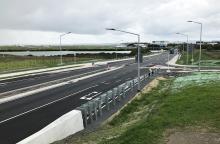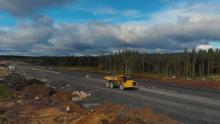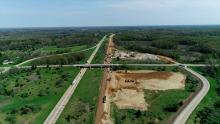
The global pandemic has had a huge impact all around the globe, with the threat to human health affecting all industries and all activities. However, the latest technology is offering solutions and helping firms to adopt systems that are already available. This is certainly becoming apparent in the construction sector, where contractors and technology suppliers are meeting the many challenges posed by the pandemic.
Construction activity was halted initially by the pandemic in many areas but then was able to commence again by following new practices, with technology playing a key role. Pete Large is in charge of civil construction field solutions at Trimble and he believes that the pandemic has certainly affected the adoption of technology in construction. He commented, “In the civil engineering sector we’re definitely seeing some trends there.”
Large believes that the need for social distancing on construction sites has led to changes in the way personnel work. He thinks that one way in which this has been apparent is in the way 3D data is transferred to construction equipment onsite. In past years, this has been done manually, “…a lot of customers have been taking sticks to machines.”
However, the need to ensure social distancing has forced contractors to change the way they work and to minimise physical interaction between personnel as well as to utilise distancing measures. He said, “More people are using the remote capabilities to take data to the machines and also use remote diagnostic technologies.”
According to Large, having already implemented these measures, contractors are likely to retain them once the worst of the pandemic has passed. “All these things we’ve been forced to do because of the pandemic will stick.”
The reason behind this switch is technology delivers increased efficiency. For example, transferring data to and from machines wirelessly at the beginning and end of the working day is far more efficient than having to take a USB stick to download into a construction machine at the start of the shift, then using another stick to download as-built data at the end of a shift. Wireless data transfer even allows for continuous tracking of machine operation, providing a real-time view of operations onsite and allowing accurate recording of as-built data.
Some sectors of the construction industry are already benefitting from the use of this sophisticated technology more than others. Large said, “It’s certainly in use in earthmoving and we’ve seen that.”
He has noted that an unexpected change in the construction sector has been the wider adoption of new technologies in remote training of personnel. Machine simulators, for example, have allowed operators to get up to speed on equipment use without needing to have an instructor sitting alongside and ensuring safe social distancing measures are employed. These simulators have been available for many years but the benefits they offer in allowing safe distancing have become more widely appreciated. The ability to deliver comprehensive operator training in a safe environment and without needing to use a working machine offers a cost saving to the contractor. Large said, “…and I think it will endure after the pandemic”.
The pandemic has posed a range of new challenges for construction firms. Building and construction management as well as project managers have been considered essential workers. Project workers, in particular, have been considered too valuable to be allowed onsite due to constraints on social contact and the need to minimise the risk of spreading the virus to essential workers. To get around this challenge, there has been a mix of technology employed in the industry. Large said that Trimble has seen a significant increase in demand for software allowing site personnel to use smartphones to take photos, which can then be used to provide accurate records on work that has been completed.
Large commented, “All of this stuff existed before the pandemic but organisations were resistant to it. With the pandemic, they went into exploring mode and quickly found new paths. There was a dogged determination to get work done.”
He continued, “Contractors want to minimise the number of people onsite, so they inspect and approve remotely using photos, scanners and sensors. These tools allow inspectors to perform their work remotely and do inspections.”
Clients too have adapted their practices to meet these new challenges. Large has observed that many municipalities have now changed their regulations to allow inspections to be carried out remotely. He explained that this has helped deliver a big increase in productivity. “In the past the inspection process could take up to two weeks, but now this is more efficient. The inspectors don’t need to travel to site and can carry out inspections remotely, so they can carry out more in the same period of time.”
Large argues that new technology is helping assist in another area too, namely the widespread labour shortage that has been affecting the construction sector increasingly in recent years and which has become more apparent during the pandemic. He said, “There’s been a squeeze on the labour market. A lot of customers have had difficulty getting skilled people onsite. The pandemic has exacerbated that problem. That’s an area where we’ve seen more interest in technology solutions.”
Customised Offering
With a steady flow of customers looking to utilise an ever-growing array of technology solutions, Trimble is changing its offering to suit. One of the key developments is the switch to the subscription model. This allows customers to pay a charge for access to a customised package of solutions. With so many products now on offer, it makes sense for Trimble to offer the platform as a service, rather than simply selling the latest all-inclusive package. Large said, “It’s a mega-trend and it’s happening in a lot of industries.”
He explained, “It’s not just a monthly payment plan. If we come out with new technology and new products, you get that. We also build other things in there like damage protection.” He continued: “The customer can get the latest and greatest hardware and software and not have to wait until the replacement date.”
The customer can select from a vast array of products and services as to what the package contains, without having to buy tools that will not be used. Meanwhile, if further options are required in the future, these can be added at a later date and for a limited period only to handle a particular task or set of tasks if necessary. Customer service also forms part of the offering and Large added: “Support is part of the package as well.”
This approach is intended to meet the requirement in major projects for the use of BIM, which is growing in importance in industry. Using BIM (building information modelling) practices helps to ensure project delivery on time and within budget by removing some of the obstacles that would otherwise delay progress, with early clash detection during design playing a vital role. Large explained, “The value of BIM is that you make all those clashes digitally, so when you come to do the actual construction you’ve already solved all those problems.”
Using BIM also means that the digital design model becomes accessible for site personnel, which is of key benefit for machine control purposes. Large said: “The key thing is to be able to get that design to site.”
The as-built data from the equipment can then be recovered wirelessly, becoming part of the final BIM model of the project, showing what was done when, where, by whom, how and with what.
With BIM in mind, Large said that the firm’s Quadri package offers ‘one source of truth’, as core project data can be collected and organised, giving all the respective parties involved in a construction project access to the correct data. He said that the Quadri collaboration platform delivers a live central BIM model, which develops continuously and helps ensure that all the stakeholders have access to the latest construction project information. “Quadri maintains a single source of truth in real time so everyone sees the actual model.”
The BIM model is not restricted to the initial design though and Large commented, “Machine control feeds that as well.”
There are other capabilities within Quadri. The system has the capability to use data recovered from laser scanning of road surfaces for example, allowing stakeholders to detect cracks and changes in the road surface over time. This offers further benefits, as it means road firms can track wear rates accurately. “They’d like to get to a point where they can be predictive,” Large added.
The capabilities of using as-built project data within BIM Models as well as laser scanning of existing infrastructure as it ages have yet to be fully realised. “For a lot of our customers it’s becoming very interesting. Our ability to connect data points in real time is one advantage,” Large observed.
Looking around the world, progress is further ahead in some countries, as Large explained: “Australia is very advanced in data flow and integration of technology. Japan is also very advanced and part of that is from the government policy.”
He also noted that the way in which Japan has adapted to utilise advanced technology in construction provides pointers for other nations. “If you look at the number of machines using machine control it is very high.” Large explained that this approach allows construction firms to be more environmentally friendly as the widespread use of digital technology is more efficient.
Despite its limited use worldwide so far, the market for advanced construction technology is vast. “There are still a lot of places in the world where old technology is being used and there is a big potential,” notes Large. India’s massive highway construction programme is a particularly ripe market for the introduction of more sophisticated construction technology. Meanwhile, the US and Europe need to upgrade and replace infrastructure and there are considerable opportunities for new technologies to evaluate the type of work needing to be carried out.
Large concluded: “The whole connected concept is good for us. The vision for construction is also that. Each stakeholder knows what the other is doing. There are aspects of what we have been through with the pandemic that’s helped introduce those solutions. Construction has done remarkably well in a challenging environment but we see 2021 as a time for recovery and catching up.”










